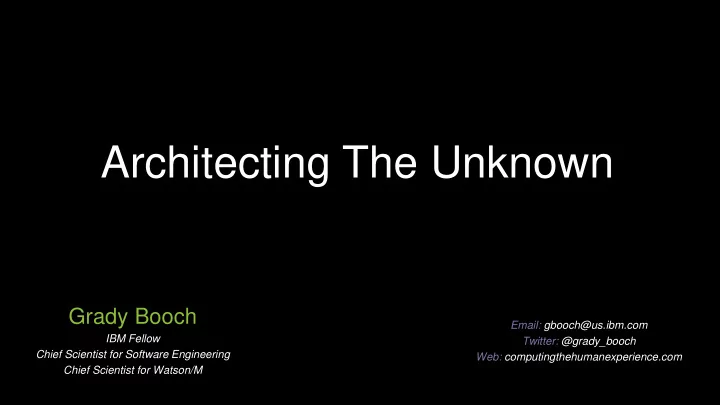

Architecting The Unknown Grady Booch Email: gbooch@us.ibm.com IBM Fellow Twitter: @grady_booch Chief Scientist for Software Engineering Web: computingthehumanexperience.com Chief Scientist for Watson/M
The fundamental premise of science is that the cosmos is understandable.
The fundamental premise of computing is that the cosmos is computable.
28
29
30
31
32
At a macro level, finding a solution to any complex problems is an iterative and incremental process with periods of punctuated equilibrium.
Functionality Cost/Schedule Compatibility Performance Reliability/Availability Capacity Security Scalability Fail safe/Fault tolerance Technology churn Resilience
• Strong vision plus fundamentals in execution – Predictability – Repeatability – Tangible artifacts – Measurable results – Stable intermediate forms – Continuous evolution – Continuous refactoring • Organizational architecture – Organized labor – Shared stories – Tribal memory – Rituals – Trust – Serendipitous connections
The code is the truth but not the whole truth.
All architecture is design but not all design is architecture. A system’s architecture is defined by its significant design decisions (where significant is measured by the cost of change).
3 Why We Architect • Vehicle for communication among stakeholders • Reasoning about an evolving system • Intentional transformation • Mechanism for attacking risk • Accountability • Preservation of tribal memory
How We Architect • Crisp abstractions • Clear separation of concerns • Balanced distribution of responsibilities • Simplicity • Grow a system through the iterative and incremental release of an executable architecture 44
5 How I Architect • Start with use cases • Shape the most significant design decisions • Reason about those decisions from the logical, implementation, and deployment views • Evolve the key abstractions, subsystems, patterns, and services by growing a minimal viable product. • Repeat
Method Method Theft Intuition Theft Intuition Classical System Unprecedented System
8 Engineering An Unprecedented System • Do the hard part first • If it works, then it’s useful • All design domains contain an irreducible kernel of problems that are best addressed through creative and heuristic approaches that combine art and science • All serious mistakes are made in the first day • No complex system can be optimum to all parties concerned, nor all functions optimized
How Unprecedented Systems Succeed • As a rule, software systems do not work well until they have been used, and have failed repeatedly, in real applications [Dave Parnas] • A complex system that works is invariably found to have evolved from a simple system that works [John Gall] • Both vertically and horizontally, the most resilient systems tend to exhibit loose coupling and tight cohesion among components [Simon] • Simplicity is the most important consideration in a design; both implementation and interface must be simple, though it is more important for the implementation to be simple [Gabriel] • Software which is flexible, simple, sloppy, tolerant and altogether forgiving turns out to be most resilient [Bosworth] • To an engineer, good enough means perfect [Alexander Calder]
Architecting The Unknown • Allow yourself to fail • Fail early • Fail often • Fail safely • Fill your tool bag • Get out of your comfort zone • Be inspired by the real world 52
Software is the hidden writing that whispers the stories of possibility to our hardware.
Recommend
More recommend